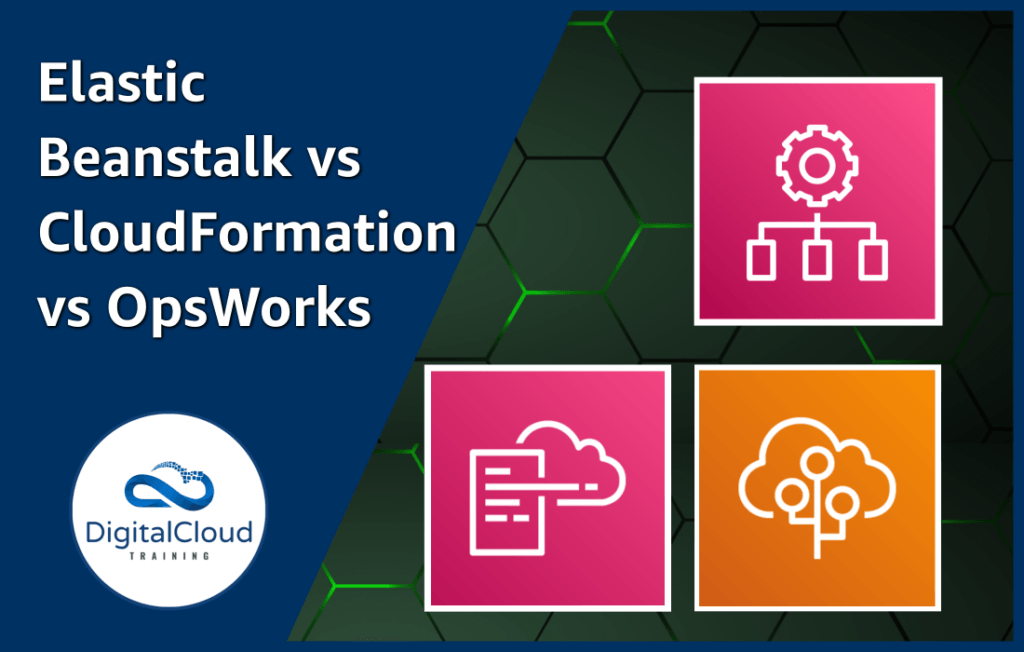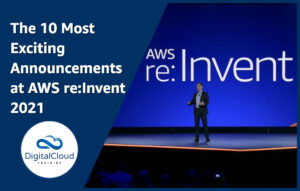Elastic Beanstalk vs CloudFormation vs OpsWorks
Please use the menu below to navigate the article sections:

There is great power in using automation and AWS managed services to offload the heavy lifting in application building and infrastructure deployment.
With AWS, you have many choices when you don’t want to worry about the manual provisioning of infrastructure – today, we’ll focus on Elastic Beanstalk, CloudFormation and OpsWorks!
These three services are often misunderstood and confused with each other. Knowing the concrete differences between Elastic Beanstalk vs CloudFormation vs OpsWorks will help improve your career aspirations and help you succeed in your AWS cloud journey. We have created this cheat sheet on Elastic Beanstalk vs CloudFormation vs OpsWorks as a resource to clear any misunderstanding once and for all.
We are going to break down and compare each of these services by category, and discuss similarities and differences between each of these seemingly similar services.
General Overview
Let’s start with some general features and key descriptions of Elastic Beanstalk vs CloudFormation vs OpsWorks.
AWS Elastic Beanstalk is a PaaS tool (Platform as a Service) in which you upload your application code to the Elastic Beanstalk service, and it simply builds your application for you. It handles everything from load balancing and scaling to application monitoring and more.
AWS CloudFormation is an IaC tool (Infrastructure as code) that provisions AWS infrastructure through the deployment of CloudFormation templates. You write your template, upload it via CloudFormation, and the service will automate the build of whatever you define in your code.
AWS OpsWorks on the other hand is a configuration management tool, providing managed support for the popular tools Chef and Puppet. There are three sub-services within OpsWorks, namely AWS Opsworks for Chef Automate, AWS OpsWorks for Puppet Enterprise, and AWS OpsWorks Stacks.
Feature Comparison
Firstly, AWS Elastic Beanstalk takes your pre-written application code (in a number of different programming languages) and you simply upload it to the Elastic Beanstalk console. Elastic Beanstalk will then provision the necessary components behind the scenes, and your application will work – with no knowledge of the infrastructure involved. Some of Elastic Beanstalks’ main features are as follows:
- Built in application monitoring using Amazon CloudWatch and AWS X-Ray allow you to gain deep insights into your Beanstalk environments.
- Elastic Beanstalk is compliant with ISO, PCI, SOC 1, SOC 2, and SOC 3 compliance along with the criteria for HIPAA eligibility.
- You can use AWS Graviton (arm64-based processors) to allow for an optimal price to performance ratio.
AWS CloudFormation on the other hand is slightly different in that you don’t design applications per se, but you design the infrastructure to run your applications on. You don’t write your AWS CloudFormation templates to behave like application code, instead you use either JSON or YAML to give the AWS CloudFormation APIs the instructions to provision AWS services within your environment.
In short, Elastic Beanstalk builds full applications, and CloudFormation builds infrastructure. Let’s view some of CloudFormation’s key features:
- Allows for easy cross-region and cross-account management, ensuring you are able to be as highly available as possible, with a single template.
- There are no manual steps which can lead to security vulnerabilities or errors, and you can use Rollback functionality to ensure that unless something isn’t perfect, it doesn’t get built.
- With Change Sets you can preview the changes the will be made when you update a stack without actually updating the production stack.
- It takes a lot of the heavy lifting off your hands through automating the creation, update, and deletion of your infrastructure.
OpsWorks on the other hand is simply a managed service for the use of the popular configuration frameworks Chef and Puppet. It is used for deploying applications explicitly with these tools only.
OpsWorks does too have additional functionality that is explicitly tied to Chef and Puppet, like self-healing, using layers etc. Compared to CloudFormation, OpsWorks is more focused on orchestrations and builds alongside the software configuration, and less on what and how AWS resources are procured on your behalf.
What each service does and how to use it
The AWS Elastic Beanstalk service (being a PaaS product) builds full scale applications and includes everything need to run your code in a production environment. You write your application code like you normally would and simply add it into Elastic Beanstalk and full applications are built – not just the infrastructure.
CloudFormation solely provisions the infrastructure ready for you for you to populate with your applications. There is a wealth of internal documentation on writing CloudFormation templates, the downside being that writing effective templates will involve some learning if you have either written in Terraform, or haven’t had exposure to IaC yet.
OpsWorks is also capable of building automation into your cloud deployments through the main three aforementioned services, and they provide different functionality comparing AWS OpsWorks vs CloudFormation vs Elastic Beanstalk:
- AWS Opsworks for Chef Automate is a hosted version of Chef Automate. This consists of a wide range of tools providing configuration control and includes automatically patching, updating, and backing up your server
- AWS OpsWorks for Puppet Enterprise gives you access to all of the Puppet Enterprise features – as is also a fully managed version of a popular tool – however the difference being it is based on Puppet. It works seamlessly with your preconfigured Puppet code with minimal to no changes.
- AWS OpsWorks Stacks allows you to arrange your architecture using appropriate methodologies e.g. test, development, production and you can interact with each layer independently.
- With OpsWorks you can ensure your traffic is safely encrypted using SSL.
Use Cases
We have devised this simple table to show some broad difference in the services, so you can understand each service as deeply as possible.
Use Case | Blue-Green deployments | Managing Multi-Region deployments | EC2 Focused Architecture | Pre-Baking AMIs | In-place application upgrades | Building Test and Dev Environment |
OpsWorks |
|
| 🗸 | 🗸 | 🗸 | 🗸 |
CloudFormation | 🗸 | 🗸 |
| 🗸 | 🗸 | 🗸 |
Elastic Beanstalk | 🗸 | 🗸 |
|
| 🗸 | 🗸 |
Learn how to Master the AWS Cloud
AWS Training – Our popular AWS training will maximize your chances of passing your AWS certification the first time.
Membership – For unlimited access to our cloud training catalog, enroll in our monthly or annual membership program.
Challenge Labs – Build hands-on cloud skills in a secure sandbox environment. Learn, build, test and fail forward without risking unexpected cloud bills.




